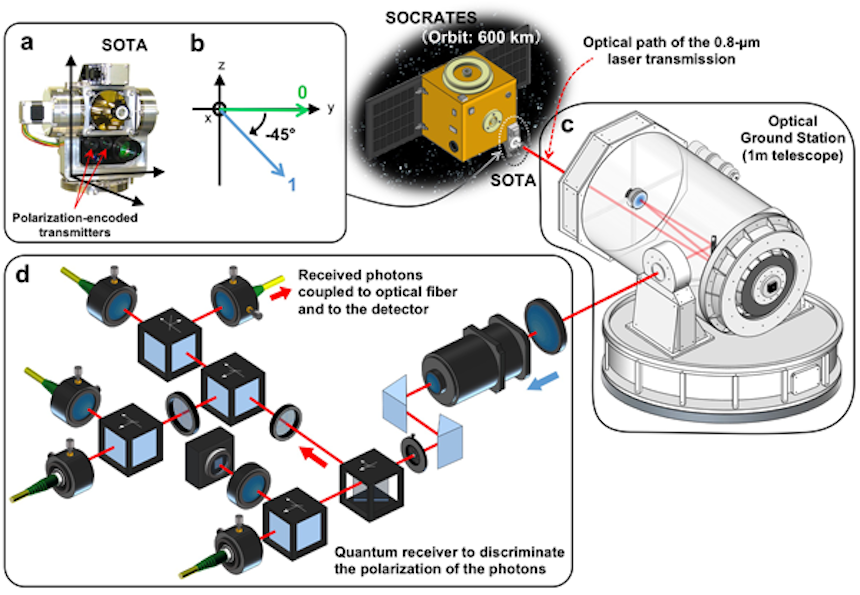
a. Picture of the lasercom terminal SOTA.
b. Polarization states that encode the bits of the transmitted information.
c. Optical ground station.
d. Configuration diagram of the quantum receiver.
The National Institute of Information and Communications Technology (NICT) developed the world’s smallest and lightest quantum-communication transmitter (SOTA) onboard the microsatellite SOCRATES. NICT succeeded in the demonstration of the first quantum-communication experiment from space, receiving information from the satellite in a single-photon regime in an optical ground station in Koganei city. SOTA weighs 6 kg and its size is 17.8 cm length, 11.4 cm width and 26.8 cm height. It transmits a laser signal to the ground at a rate of 10 million bits per second from an altitude of 600 km at a speed of 7 km/s. We succeeded in correctly detecting the communication signal from SOTA moving at this fast speed. This is a major step toward building a global long-haul and truly-secure satellite communication network.
NICT says that as a result of this research, NICT demonstrated that satellite quantum communication can be implemented with small low-cost satellites, which makes it possible to many research institutions and companies to use this key technology. It is an achievement that opens a new page in the development future global communication networks, being a big boost to the space industry.
The results of this research are published in Nature Photonics.
The technologies required to launch small satellites at a low cost have progressed immensely during this century, and significant efforts are being made to develop satellite constellations to achieve a global communication network covering the entire Earth. However, there is a need for a technology that can transmit large amounts of information from the space to the ground in short periods of time, and the current RF bands are already congested, setting a bottleneck of communication capacity. By using lasers, satellite optical communication has a readily-available frequency band and can transmit with higher power efficiency and with smaller and lighter terminals. Thus, it is expected to be a key technology to support the future satellite communication networks. Quantum communication, and more specifically, Quantum Key Distribution (QKD) is another key technology to guarantee the information security of the next global communication networks. Current QKD links are limited to several hundreds of km, thus implementing satellite-to-ground QKDis a fundamental step in this endeavor. QKD research is actively conducted in Japan, China, Europe, Canada and the United States. In August of 2016, the University of Science and Technology of China launched a large (635 kg) quantum-communication satellite and performed a quantum-entanglement experiment with two ground stations.
SOTA is the world’s smallest and lightest quantum-communication transmitter (6 kg weight, 17.8 cm length, 11.4 cm width, and 26.8 cm height) carried by the microsatellite SOCRATES. SOTA transmitted two polarization states, encoding ‘0’s and ‘1’s, to the ground at a rate of 10 million bits per second. The signals from SOTA were received at the NICT optical ground station in Tokyo’s Koganei city, using a 1-m telescope in order to collect the transmitted photons and guide them to the quantum receiver to decode the information using a QKD protocol.
The signal that arrives at the 1-m telescope is extremely weak, with an average of 0.1 photons per received pulse. NICT says it has developed the technology to perform the time synchronization and polarization reference frame matching between the satellite and the ground station directly from the QKD signals, as well as a quantum receiver capable of detecting such a weak signal with low noise. We demonstrated the world’s first quantum communication from a 50-kg microsatellite. This will enable the development of future secure links from space by using quantum cryptography to completely prevent information leakage.
Future prospects
The technology developed in this project demonstrated that satellite quantum communication can be implemented by using low-cost lightweight microsatellites. Therefore, it is expected that many research institutes and companies, which are interested in this technology, will accelerate the practical application of quantum communication from space. In addition, since it was proved that long-distance communication is possible with very-low electric power, this will open up a path to speed up deep-space optical communication with exploration spacecraft.
“In the future, we plan to further increase the transmission speed and improve the precision of the tracking technology, to maximize the secure key delivery from space to ground by using quantum cryptography enabling a truly-secure global communication network, whose confidentiality is currently threatened by the upcoming development of quantum computers,” NICT says.
— Read more in Hideki Takenaka et al., “Satellite-to-ground quantum-limited communication using a 50-kg-class microsatellite,” Nature Photonics(10 July 2017) (DOI: 10.1038/nphoton.2017.107)
This article is published courtesy of Homeland Security News Wire.

